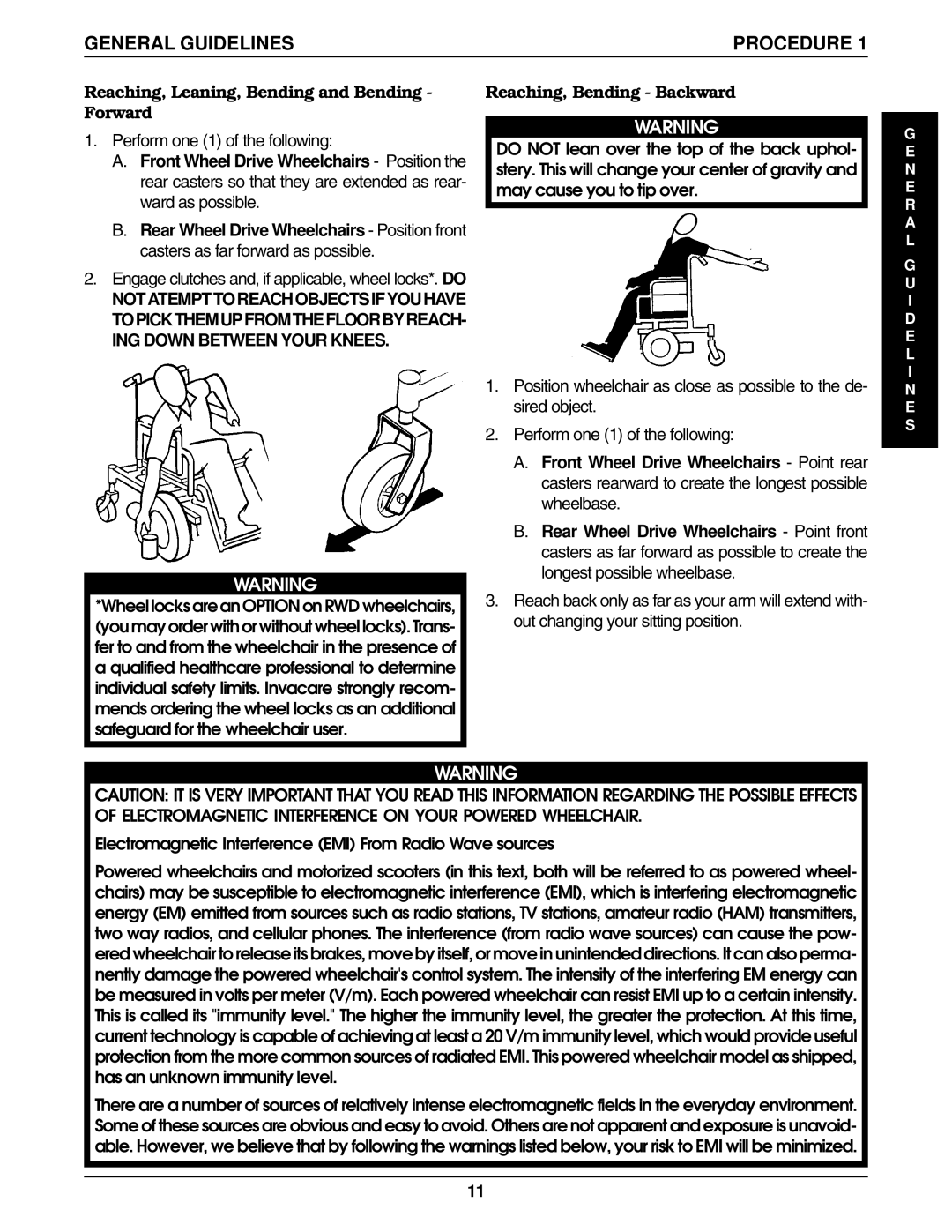
GENERAL GUIDELINES | PROCEDURE 1 |
Reaching, Leaning, Bending and Bending - Forward
1.Perform one (1) of the following:
A.Front Wheel Drive Wheelchairs - Position the rear casters so that they are extended as rear- ward as possible.
B.Rear Wheel Drive Wheelchairs - Position front casters as far forward as possible.
2.Engage clutches and, if applicable, wheel locks*. DO
NOT ATEMPT TO REACH OBJECTS IF YOU HAVE TOPICKTHEMUPFROMTHEFLOORBYREACH- ING DOWN BETWEEN YOUR KNEES.
Reaching, Bending - Backward
WARNING
DO NOT lean over the top of the back uphol- stery. This will change your center of gravity and may cause you to tip over.
G E N E R A L
G U I D E L I
WARNING
*WheellocksareanOPTIONonRWDwheelchairs, (youmayorderwithorwithoutwheellocks).Trans- fer to and from the wheelchair in the presence of a qualified healthcare professional to determine individual safety limits. Invacare strongly recom- mends ordering the wheel locks as an additional safeguard for the wheelchair user.
1.Position wheelchair as close as possible to the de- sired object.
2.Perform one (1) of the following:
A.Front Wheel Drive Wheelchairs - Point rear casters rearward to create the longest possible wheelbase.
B.Rear Wheel Drive Wheelchairs - Point front casters as far forward as possible to create the longest possible wheelbase.
3.Reach back only as far as your arm will extend with- out changing your sitting position.
N E S
WARNING
CAUTION: IT IS VERY IMPORTANT THAT YOU READ THIS INFORMATION REGARDING THE POSSIBLE EFFECTS OF ELECTROMAGNETIC INTERFERENCE ON YOUR POWERED WHEELCHAIR.
Electromagnetic Interference (EMI) From Radio Wave sources
Powered wheelchairs and motorized scooters (in this text, both will be referred to as powered wheel- chairs) may be susceptible to electromagnetic interference (EMI), which is interfering electromagnetic energy (EM) emitted from sources such as radio stations, TV stations, amateur radio (HAM) transmitters, two way radios, and cellular phones. The interference (from radio wave sources) can cause the pow- ered wheelchair to release its brakes, move by itself, or move in unintended directions. It can also perma- nently damage the powered wheelchair's control system. The intensity of the interfering EM energy can be measured in volts per meter (V/m). Each powered wheelchair can resist EMI up to a certain intensity. This is called its "immunity level." The higher the immunity level, the greater the protection. At this time, current technology is capable of achieving at least a 20 V/m immunity level, which would provide useful protection from the more common sources of radiated EMI. This powered wheelchair model as shipped, has an unknown immunity level.
There are a number of sources of relatively intense electromagnetic fields in the everyday environment. Some of these sources are obvious and easy to avoid. Others are not apparent and exposure is unavoid- able. However, we believe that by following the warnings listed below, your risk to EMI will be minimized.
11
